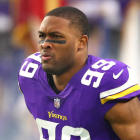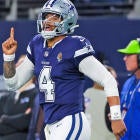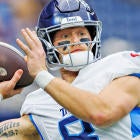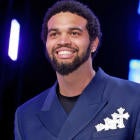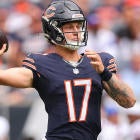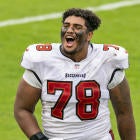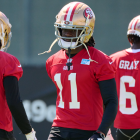EAGAN, Minn. -- It is illegal for NFL teams to practice in full pads before summer training camp, but one look at Minnesota Vikings defensive end Danielle Hunter during June's minicamp would have been enough to convince you the reigning NFC North champions had been skirting the rules.
That's not because the Vikings actually gave their fourth-year lineman some game-day gear on the low. It's because Hunter's chiseled frame looked a whole lot like it came pre-padded. And then some.
Practicing just out of the shadow of the towering steel temple that is the team's TCO Performance Center, a 40-acre headquarters in the Vikings' new corporate campus, Hunter still managed to stand out. But it was not just his unmatched and impossible-to-overstate physique that set him apart on a Minnesota team that, in 2017, was one victory away from the Super Bowl and owned the NFL's No. 1-ranked defense.
It was also the fact he's probably the best professional pass rusher whom nobody's talking about.
Desperately wish you had a 30-minutes-or-so, daily NFL podcast in your podcast app every morning by 6 a.m.? Put some Pick Six Podcast in your life and join Will Brinson as he breaks down the latest news and notes from around the league, as well as the win totals on a team-by-team schedule. It's a daily dose of football to get you right for that commute or gym trip. Subscribe: via iTunes | via Stitcher | via TuneIn | via Google Play
Next generation
On a roster that rivals the defending title-winning Philadelphia Eagles in terms of top-to-bottom talent, it's easy to see why Hunter may be overlooked. There's an argument to be made that Stefon Diggs, Kyle Rudolph, Everson Griffen, Eric Kendricks, Anthony Barr, Xavier Rhodes, Harrison Smith and new $84 million quarterback Kirk Cousins have all, at some point, been deemed faces of the Vikings franchise. Even among his own front-four peers, let alone stars around the NFL, Hunter doesn't quite command the spotlight of Griffen, Linval Joseph or Sheldon Richardson.
And yet, in a league where the top crop of sack artists is still populated largely by seasoned veterans, who else could possibly be the cornerstone of the NFL's next generation of edge rushers? Joey Bosa, Myles Garrett, Jadeveon Clowney and DeMarcus Lawrence might come to mind.
But Hunter is taller than Bosa. He's faster than Garrett. He's healthier than Clowney. And he's still younger than almost all of them.
"I came in at 20 years old," Hunter said in an interview at minicamp, "and I realized that my age is an advantage. People come into the league at like 23, 24, so I used these past three years to learn as much as I possibly can and take notes from other guys."
Youth without production is merely projection, though, and that's why the value of the fourth-year Viking's 23-year-old bio is twofold.
First, it shows that Hunter, who had only 4½ sacks in college, has come a long way since he was a third-round draft pick in 2015, when NFL Network's Mike Mayock said the defensive end "was nowhere near ready to come out of LSU" because "he still has to learn how to play football."
His 25.5 sacks and 33 tackles for loss in the three years since should be proof that he's done more than that. After a six-sack rookie campaign, the former Tigers standout led the Vikings with 12.5 sacks in 2016 and then became a full-time starter in 2017, posting another seven sacks and ranking among the NFL's best in stops behind the line of scrimmage.
And second, perhaps more importantly, it shows that, at 23 with maybe two Pro Bowl-caliber seasons already under his belt, Hunter has yet to graze his ceiling -- and he should have plenty more time to do just that.
Impeccable training regimen
One of the reasons -- other than owning a birth certificate that confirms he was both the youngest player to ever lead the Vikings in sacks and the NFL's youngest player as a 20-year-old rookie -- is the impeccable training regimen that made his body look padded during padless June practices.
Originally from Jamaica, Hunter has always been tall, jumping in track and field and starting as a wide receiver at Morton Ranch High School in Texas. But he's gone from big to hulking in recent years, leaving college at 240 pounds, starting in the NFL at 252, bulking up to 260 in 2017 and adding another five pounds this offseason. Only pictures or an in-person look can do justice the sheer size of his arms -- boulder-like biceps that, over the years, have prompted teammates to exchange "D," his most common nickname, for "Tarzan," "Terminator," "The Hunter," or "99 Problems," a play on his jersey number.
"He came in around 225 or 230 pounds, or it may have been a little less than that, so he grew," former LSU defensive coordinator John Chavis said over the phone. "We called him Tarzan because he was kind of yoked up, but he was a little bit smarter than that."
Hunter's even been known to discuss his body fat percentage, attributing the bulging appearance of his arm veins to a low BFP. And although he's added weight since last taking the field, he thinks he's "definitely quicker, more quick-twitch" and that those BFP numbers are still indicative of his workout supremacy.
The average BFP of a healthy male, according to HealthStatus, is between 18 and 25. And he clears that by a football field.
"I haven't measured it recently," he said. "But when I did, it was in the single digits."
Miami Dolphins defensive tackle Davon Godchaux, one of Hunter's LSU teammates, once joked to Louisiana's The Advocate that he thought his "unreal, freakish" fellow lineman was lying so as not to brag, saying he believed Hunter had a two-percent BFP.
For Hunter, of course, physical fitness has never been about impressing other coaches or players, even though he admitted with a smile that he'd "be walking around with my shirt off" if the Vikings ever took a team beach trip. Taking care of his body is just something he learned from fellow end Brian Robison, who's now 35 years old and entering his 12th year with the Vikings. And it's something -- obvious or not -- he knows is key to succeeding in his field.
"I never get out of shape, because this is is my job," he said. "This is what I do for a living. Why get out of shape?"
It's a sentiment most athletes might preach, but most athletes also don't look like Hunter.
Chavis, who now coaches the University of Arkansas defense and has tutored NFL stars like Tyrann Mathieu, Patrick Peterson, Jerod Mayo and Leonard Little during stops at LSU, Texas A&M and Tennessee, attributed that to Hunter's business-like attitude.
"Once you get to that level, I don't think there's anything that really sets anybody apart," he said. "It's the guys that are totally committed that stand out, and he was a guy that was very serious about football even at a young age. When something's important to him, he's got that work ethic."
Team player
Most athletes also don't boast Hunter's long-term promise -- that of a pass rusher who, despite playing in the shadow of his own team's all-star linebackers, cornerbacks and safeties, could ultimately be the backbone of what figures to be an annual title contender for the next half-decade. It's a passing -- and pass rushing -- game, after all, and there aren't many others in the NFL with Hunter's combination of youth, size and production.
Even the reasons for his lack of Bosa- or Clowney-level headline power paints him as a model 23-year-old, if not a pillar of a Vikings team that's prided itself on quiet, disciplinarian leadership.
Whereas Bosa and Clowney came into the NFL disputing either multi-million-dollar contract offers or accusations of taking plays off on the way to massive No. 1-pick fanfare, Hunter is just weeks removed from landing his own lucrative new deal -- a reported $72-million extension that makes him one of the league's top-10 highest-paid defensive ends. And yet he would prefer to forgo contract and player comparisons for an analysis of, say, how his strength off the edge is affecting the Vikings' win total.
"I'm not really worried about other people's stats and all that stuff," he said. "Some people are big on that, but it's like nothing to me. There's always a percentage of the amount of sacks that we get as D-linemen that improves our winning percentage, but I'd rather the season that I had last year instead of the year before that (when he had more sacks). I helped my team to where they needed to be, in the NFC Championship game."
In other words, he's a team player.
A whole lot of 'want-to'
It's also no wonder, then, that one of the teammates Hunter most looks up to is Cousins, who chose the Vikings this year on his own free agency tour and is looking to succeed a long line of recent Minnesota quarterbacks.
"I've kind of noticed something about guys that are drafted, like, mid-round," Hunter said, referring to Cousins but perhaps also himself. "They have a want-to about things. I was sitting down with Kirk one day, and he was just saying he likes it here, how guys just come here and come to work -- they don't just come here as a hobby, they come to work, and I like that about him."
Vikings defensive line coach Andre Patterson confirmed Hunter had the same attitude back in 2015, before the team had moved to its pristine practice facility, its luxurious U.S. Bank Stadium and into the conversation of Super Bowl contenders.
"I remember when I got drafted," Hunter said, "Coach Dre told me to come in, focus and just work my butt off, and everything's going to pay off. There was nothing else to do."
He was right. Like the team that employs him, Hunter is a whole lot bigger, shinier and valuable these days.
All that's left is for people to start noticing.









